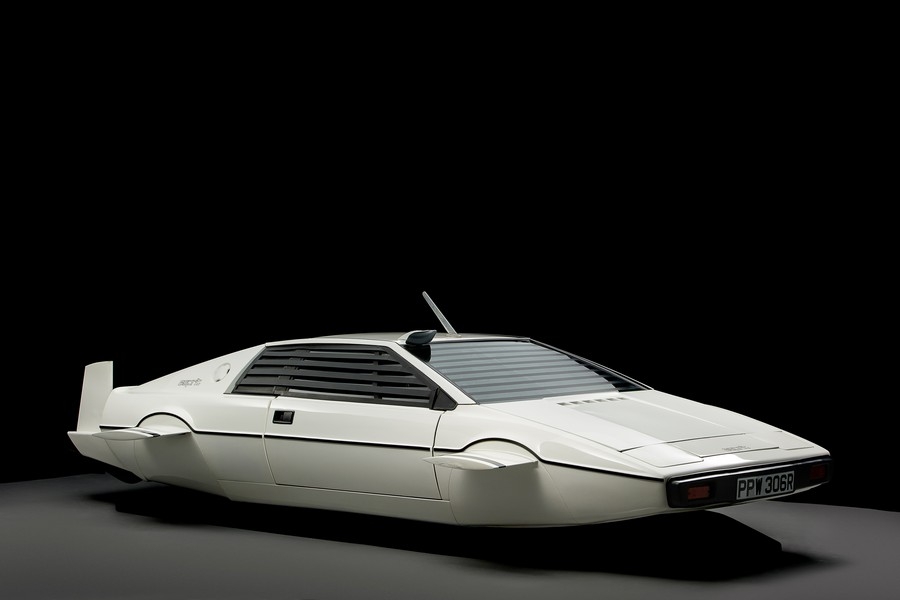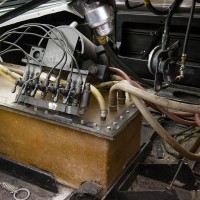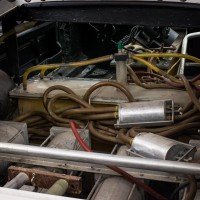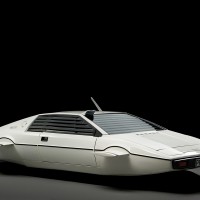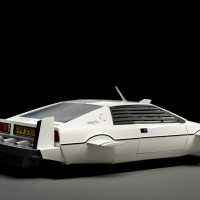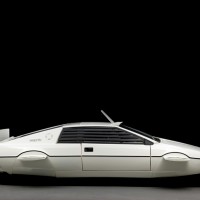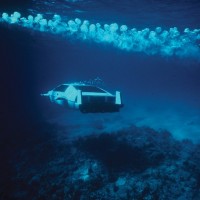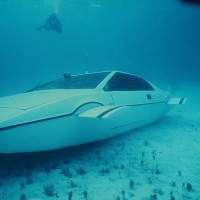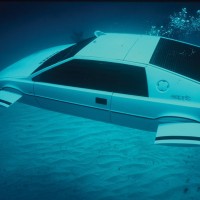SCM Analysis
Detailing
| Vehicle: | 1976 Lotus Esprit 007 Submarine Car |
| Years Produced: | 1976 |
| Number Produced: | One |
| Original List Price: | $100,000 |
| Tune Up Cost: | About $1m |
| Chassis Number Location: | None |
| Engine Number Location: | Not quoted, but there are four of them |
| Club Info: | Ian Fleming Foundation |
| Website: | http://www.ianflemingfoundation.org |
| Alternatives: | 1966 Batmobile, Millennium Falcon, 1981 DeLorean DMC-12 with flux capacitor |
This movie car/submarine/oddity, Lot 243, sold for $959,629, including buyer’s premium, at RM’s annual Automobiles of London sale at Battersea Park on September 9, 2013.
Ah, Wet Nellie. The nickname stems from another Bond gadget, “Little Nellie,” the autogyro used in the 1967 Sean Connery Bond movie “You Only Live Twice.” Its creator, Commander Ken Wallis, flew the device. Sadly, Wallis recently flew to the stars for the last time.
I admit to always thinking the underwater scenes (apart from the wheel retraction shot that was obviously done by hand in an empty shell) were accomplished with a model, but no, this was a fully functional “wet” submarine. That means it has neutral buoyancy to run underwater but is not airtight, so the pilot needs to wear scuba gear.
In this case it was ex-Navy SEAL Don Griffin, a technician and test pilot for Perry Oceanographics, which built the device.
The rugged life of a movie car
Five other shells aside from this one and the “tire shell” were provided by Lotus and used for various scenes — including being shot off the end of a pier in Sardinia by air cannon.
According to Doug Redenius, co-founder of the Ian Fleming Foundation, after filming, two shells were left behind in the Bahamas and given as souvenirs to Roberts Scrap Metal Company, which assisted with the heavy equipment for the shoot. The tire shell exists today in poor condition in a Florida museum. The fin shell is whereabouts unknown, while the missile shell is owned by the Ian Fleming Foundation and is on display as part of the ongoing 50th Anniversary of James Bond Exhibit at the National Motor Museum in Beaulieu, England.
The first of the pier shells was damaged by the air cannon during filming, and it is presumed to have been discarded. The other pier shell may have been unused or used more lightly. In any event, it was later unofficially retrofitted with mock-up gadgets and sold in the late 1980s, Redenius said.
Which leaves this one, the most complex and expensive of them all. As presented, it retained its interior plumbing for buoyancy, watertight central tank for the batteries (long since gone) and air supply for the driver — all of which will need renewing if it is ever to submerge again. Propulsion was by four battery-powered electric motors under the tail, and the bank of props remains, if not the motors.
After filming, the story is that in conjunction with the 1977 release of “The Spy Who Loved Me,” U.S. Lotus (Lotus East) executive distributor Fred Stevenson procured “Wet Nellie” for display at auto shows.
According to correspondence between himself and the location manager for Eon in the Bahamas, Stevenson remembers the Lotus was full of sand and seaweed upon delivery in New York, and there was no time to clean it prior to its first public debut at the New York Auto Show. Appearances at shows in Cleveland, Chicago, Denver and Los Angeles followed, and Lotus West took over control of the car/submarine. Stevenson relates having great fun with the Lotus, discussing its unique features with dignitaries and celebrities who enjoyed having their photographs taken with Wet Nellie, some of which were reproduced in the catalog.
Eventually, the Lotus was shipped to Long Island and then transferred to a storage unit in Holbrook, NY. The lease was reportedly for a 10-year rental, paid in advance.
Storage unit find?
But 10 years later, with rent unpaid, the unit’s contents were put up “blind” at public auction. A modest winning bid, said to be $100, from a local couple brought surprise and wonder when the blankets were removed to reveal the iconic 007 Submarine Car.
The roof had been damaged, but it was otherwise intact. Those owners, who were selling the car at RM, recounted that the CB radios of highway truckers were all abuzz about sighting of the famed Lotus during its ride to a new home.
After positive authentication, the Lotus was cosmetically restored and fitted to a custom-designed display trailer and exhibited occasionally, including a stint at the Petersen Automotive Museum in Los Angeles, but it was mostly kept closely under wraps — until now.
Just like the Bond “Goldfinger” Aston Martin DB5 that RM sold at the Battersea Evolution events center three years ago, Wet Nellie was displayed inside a special set — this time with sand and running water to suggest an undersea setting.
Ignore the D-type…
On auction day, RM’s Don Rose inhabited this world, with interviews from TV crews from around the globe. None of those journalists seemed to be aware that there were two cars with Le Mans history in the room: the D-type s/n XKD504 and the Ecurie Francorchamps 275 GTB/C. Such is the short reach of the popular-media reporters, none of whom likely were old enough to remember the film when it was first released.
Come the bidding…. The Lotus sold to an anonymous phone bidder after DJ and car collector Chris Evans had been spotted taking a serious interest on the morning of viewing. The top bid was 10% under the rather hopeful lower estimate of £600k ($950k).
Bond cars bring big bucks
Bond cars attract a special kind of buyer, and history tells us that 007 provenance increases the value roughly tenfold over a stock example. The most real of the “real” Bond Aston Martin DB5s fetched $4.6m at RM’s Battersea auction in 2010 — when average DB5s were selling for £300k.
Another “The Spy Who Loved Me” Bond Esprit sold at auction was one of the two road cars used for filming in Sardinia, including the helicopter chase scene. It fetched £111,500 ($165,020) with Bonhams at its old Olympia venue in December 2008, even though it was the “lesser” of the two — that is, it appeared briefly in the handover scene with Roger Moore and Desmond Llewelyn, who was playing Q.
Most of the time, the car was used as a camera platform to shoot the “hero” car (driven by Lotus head of chassis development Roger Becker, when the stunt drivers couldn’t make it behave as they wanted), as nothing else available could keep up. That 2008 price represented about 10 times what an S1 Esprit in good nick would have fetched.
Our subject car/submarine, which you can’t even drive and will cost a ton to recommission, fetched five times the price of the Bond road Esprit, but it is perhaps the most famous movie prop in the world.
By comparison, the multitude of “Eleanor” Mustangs said to have been used in the remake of “Gone in 60 Seconds” routinely fetch $150,000, and “General Lee” Dodge Chargers are ten a penny. So, very well sold.
What price now the “American Graffiti” pairing of the Milner Deuce coupe and the Falfa ’55 Chevy? ?
(Introductory text abridged from RM’s catalog description.)
